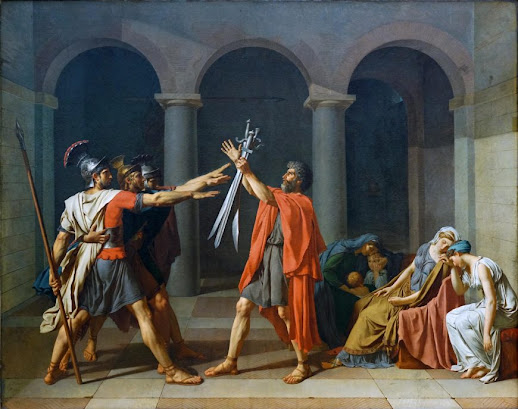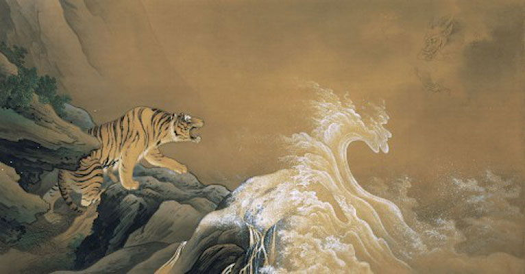Classical Era - Revolution & Art
3.3m x 4.25m, oil on canvas
Rome
The Death of General Warren at the Battle of Bunker's Hill, 17 June, 1775 (c. 1786) by John Trumbull
65.1cm x 95.6cm, oil on canvas
America
Samuel Adams (c. 1772) by John Singleton Copley
125.73 cm x 100.33 cm, oil on canvas
America
Neoclassical Style
Neoclassicism gained popularity as a direct opposition to the frivolous sensuality of Rococo painters of the time. Neoclassicist artists believed that art should be cerebral, not sensual. Neoclassical art is defined by its use of strong drawing and smooth surfaces (no visible brush strokes).
Revolutions
During the late 1700s, the American Revolution and the French Revolution were both current and relevant topics. As such, Neoclassicists wanted to express a rationality and seriousness befitting such a serious time. Additionally, the Enlightenment occurred during this time; philosophers believed one could control their destiny by following the laws of nature and questioned the validity of the monarchy and other established institutions. Neoclassical style is connected to the classical tradition, as it represents moderation and rational thinking.
Analysis
- Oath of the Horatii
This painting depicts an event that took place in ancient Roman history, when Rome was at war with Alba. Instead of utilizing armies, three brothers from each side are sent to battle. The Romans chose the Horatii brothers, and Alba chose the Curatii brothers. There are intermarriages between these two families, so no matter which family wins the battle, both sides will lose. The women look rather sullen because they will lose a betrothed or a family member. The man holding the sword is the Horatii father, and his three sons are taking an oath to fight to the death. Historians are skeptical that this event actually happened; rather, it is likely popular legend.
David is displaying in this painting the brothers' willingness to make sacrifices for their families and even die for their country. This corresponds with what the French revolutionaries were facing at that time. Although this was painted several years before the revolution, it was informed by the same philosophical values about monarchists. This painting eventually became an icon of the revolution.
This is clearly neoclassical in style because of the sharp lines and well defined forms, especially when compared to the flowing Rococo style. The vanishing point of the father's hand holding the swords has many lines extending to it. The male figures are strong and detailed. The colors are sharp and realistic. One could imagine how a revolutionary could take inspiration from this painting. Personally, I appreciate this piece for its storytelling ability and historical value; but I do not find it particularly appealing otherwise.
-The Death of General Warren at the Battle of Bunker's Hill, 17 June, 1775
John Trumbull, an American, created a "Revolutionary War" series of paintings, beginning with this scene at Bunker Hill. This battle is considered to be the earliest important event in the American Revolution. The scene in this painting depicts the death of American Major General Joseph Warren. Warren was mortally wounded by a musket ball. British Major John Small is seen grabbing a bayonet to prevent the dying soldier, Warren, from being stabbed. The surrounding American soldiers faces express both concern for the dying Warren and astonishment at the benevolence that the British Major is exhibiting. By emphasizing this act of humanity by the enemy, Trumbull respects that morality goes beyond national boundaries.
Again, I can appreciate the historical value of this painting; it would be best displayed in a gallery or museum. The color and dark values used in the clouds and smoke give it an ominous feel that perfectly sets the stage for a battle. The forms here are not as sharp as in David's artwork, but the texture and details give it a realistic feel.
-Samuel Adams
This portrait of Samuel Adams displays his confrontation with Royal Governor Thomas Hutchinson the day after the Boston Massacre of March 5, 1770, where seven British soldiers fired into a crowd of Bostonians, killing five and wounding six. At the confrontation depicted here, Adams demanded the expulsion of British troops from Boston. This portrait was commissioned by John Hancock, who occasionally worked with Adams on the revolutionary effort. This portrait was displayed in Hancock's house, which was the site of important political meetings in the 1770s. Due to these meetings, this portrait became widely known and served as a source of inspiration for revolutionaries, though the artist himself was not politically outspoken.
This portrait is interesting because the viewer is has the perspective of the Royal Governor who is being confronted. The Museum of Fine Arts in Boston (MFAB) writes, "Adams's defiant gaze and gesture arrest the viewer," and, "Adams is presented as a man of reason, and the image is all the more potent for it." I think the backstory is very relevant here; I personally feel that Adams proportions look slightly off and to me this causes the image to seem less defiant than MFAB suggests. However, I can understand how this depiction of a moment of defiance would be inspiring for Americans during the American Revolution. I think that space is used effectively in this painting. Adams is positioned so that the viewer feels as if they are looking up at him which does give him a commanding presence.
References
Black McCoy, Dr. Clarie. "Jacques-Louis David, Oath of the Horatii." Smarthistory, https://smarthistory.org/jacques-louis-david-oath-of-the-horatii/.
"The Battle of Bunker's Hill, June 17, 1775." Yale University Art Gallery, https://artgallery.yale.edu/collections/objects/41
"Samuel Adams." MFABoston, https://collections.mfa.org/objects/30881
Gersh-Nesic, Dr. Beth. "Neoclassicism, an Introduction." Khan Academy, https://www.khanacademy.org/humanities/renaissance-reformation/rococo-neoclassicism/neo-classicism/a/neoclassicism-an-introduction
"Boston Massacre" National Park Service, https://www.nps.gov/articles/000/boston-massacre.htm#:~:text=Boston%20National%20Historical%20Park,and%20angering%20an%20entire%20colony.





Comments
Post a Comment